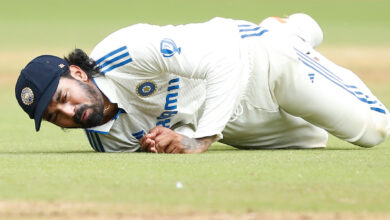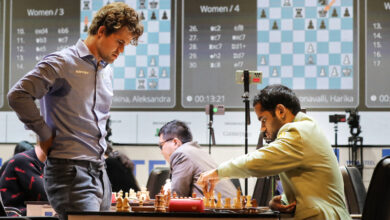‘Who is Abdul Qadir, never heard of him’: Meet Abrar Ahmed, Pakan’s new mystery spinner

Five years ago, Mushtaq Ahmed, the then head coach of Pakan’s National Cricket Academy in Lahore, asked the 19-year-old “Harry Potter” lookalike Abrar Ahmed: “Do you know who is Abdul Qadir?” Pat came the reply: “Ye kaun hai, kabhi naam nahi suna (Who is he, never heard his name).”
What a ball to get your first Test wicket! 👏
Immediate impact Abrar Ahmed 🎯#PAKvENG | #UKSePK pic.twitter.com/8tvnuGFzyo
— Pakan Cricket (@TheRealPCB) December 9, 2022
The answer left Mushtaq Ahmed in splits, and if Abrar’s brother Sajid is to be believed, the former Pakan leg-spinner couldn’t stop laughing for 10 minutes.
“Everyone started laughing and Mushtaq bhai told him ‘you’ve regered yourself as a leg-spinner and you don’t know about the greatest we ever produced,’” Sajid Ahmed tells The Indian Express from Karachi.
“When he narrated this story to us, we also started laughing. Bachpan se itni deewangi cricket ko le kar aur itne bade legend ko nahi jaanta (He was so passionate about cricket since childhood, but had no clue about such a legend),” adds Sajid.
Abrar’s coach Muhammad Masroor defended his ward. “Not his fault; he has idolized Sunil Narine all his life. You can’t blame him for not knowing the great Abdul Qadir,” Masroor said.
Abrar, Pakan’s latest spin sensation who debuted against England in the Multan Test, hails from Shinkiari, a small village on the outskirts of Mansehra near Abbottabad. But his father moved to Karachi in 1977, where he grew up playing tape-ball cricket.
Cricket came very naturally to Abrar; his father Noor Ahmed was a big fan of the Pakan team, and another elder brother Shahzad Khan, a fast bowler, represented National Bank in the domestic circuit.
“I still remember it was the Multan Test, where Virender Sehwag smashed that triple hundred, and he attacked Saqlain Mushtaq the most. Abrar was about six, and he used to point out makes in Saqlain bhai’s bowling. My father got so annoyed because of his running commentary that he locked him in another room,” laughs Sajid.
” id=”yt-wrapper-box” >
The youngest among eight siblings (five brothers and three sers), Abrar was more close to his mother. When he turned nine, Abrar’s mother asked him to do hifz (memorization of the Quran). Cricket took backstage for the next two years.
“He was the brightest among us. My mother wanted him to pursue aalima (study Islamic sciences). And for the first time, he said no to his mother. He said ‘I want to play cricket, I have no interest in becoming an Aalim,” recollects Sajid.
‘Fingers like iron rods’
For the next four years, Abrar played tape-ball cricket. One day, while returning home, he heard about a cricket trial at Rashid Latif’s academy.
Muhammad Masroor, who was Pakan’s U-19 coach, was overseeing the trials and was left awestruck with his variations.
Abrar Ahmed. (File)
“Same grip se carrom ball, leg-spin, googly, slider saare variations daal raha tha (He was bowling all variations with the same grip). He doesn’t have that massive turn. He was bowling on the stumps, and no one was able to read his lengths.
“I immediately asked him whether he had ever played with the hard ball. The answer was ‘no’. I couldn’t believe my eyes. Out of curiosity, I checked his fingers, and those were like iron rods,” shares Masroor.
In 2016, Abrar bagged 53 wickets in Zonal U-19 in Karachi. Masroor, then a fielding coach with Pakan Super League side Karachi Kings, sent his videos to Rashid Latif, who was director of cricket at the franchise. In 2017, Abrar became one of the emerging picks for Karachi in the PSL.
“He played only two games and was wicketless but impressed everyone with his brilliant spell against Peshawar Zalmi. Eoin Morgan smashed a 57-ball 80, and against him, Abrar bowled 16 balls and gave away only 17 runs, including seven dots. I remember coach Mickey Arthur, captain Kumar Sangakkara, Kieron Pollard, Chris Gayle, everyone was so impressed,” says Masroor.
‘He could have been paralyzed’
After the high came a setback. After the PSL, Abrar suffered a stage-five stress fracture and was out of action for two years.
“He could have been paralyzed. It was serious. I remember the doctor telling our elder brother and me that he might never be able to play cricket again,” recalls Sajid.
Masroor explains the reason behind the injury. “He started playing competitive cricket when he was 17. In two years, he played non-stop cricket. He bowled tirelessly in the nets. The body couldn’t take the toll. As a coach, I failed to manage his workload,” says Masroor.
Noor Ahmed kept encouraging his bedridden son. “‘Pathan ka bachcha hai tu, haar nahi maan sakta’ (You are the son of a Pathan, you can’t give up). He told him about his early struggles in Karachi, how he used to drive a taxi for 20 hours a day to make ends meet. It gave him the motivation, and he again reignited his passion for the game,” says Sajid.
Abrar made a comeback in early 2020 for Sindh’s second XI. In the Quaid-e-Azam Second XI tournament that year, Abrar took 57 wickets at 11.75.
“He was back. Next year, he was promoted into the senior team,” says Masroor.
Pressure to bowl off-spin
After making a remarkable recovery, though, he was tagged as a limited-overs bowler; Masroor got calls and texts from former Pakan cricketers asking why he wasn’t working on Abrar’s off-spin.
“Main hamesha Jasprit Bumrah ki misaal deta hun, agar wo ladka Pakan mey hota toh ye humare former cricketers uske peeche pad jaate, uski action ke wajah se (I always give the example of Jasprit Bumrah, if he had been in Pakan, our former cricketers would have been after him because of his bowling action).
“There are plenty of examples. Anwar Ali is the latest that comes to my mind. At NCA (National Cricket Academy), they changed his action, and he lost his inswing. He was never the same bowler again. In the 1980s, there was a fast bowler, Atiq-ur-Rehman, he was quicker than even Imran Khan. His bowling action was very similar to Jeff Thomson’s. He was attending his first Pakan camp, where Fazal Mahmood changed his action; he lost his pace, and never played for Pakan.
“In Pakan, most former cricketers don’t know A-B-C of cricket coaching; they just want the youngsters to admire them. You ask any legend here if they have any clue what muscle memory is.
“Arshad Khan (former Pakan off-spinner) called me and told me to tweak Abrar’s action so that he can bowl off-spin. Tell me one thing, is there any point in changing someone’s action when he is 22? I said no to Arshad. Abrar was unable to execute his googlies to left-handed batters. I said I would work on his googly, which is natural to him and will not force something on him that he has never done in his life,” says Masroor.
“They called him T20 special in Pakan. That kid was not picked any PSL team in 2021. Then before the T20 World Cup, he was picked for the seven-match T20I series against England but didn’t get a single game to showcase his skills,” he adds.
Undaunted, Abrar set the 2022-23 Quaid-e-Azam Trophy on fire, claiming 43 wickets at an average of 21.95. The second-best tally was a dant 31. Abrar took five five-wicket hauls in seven matches, earning the Test call-up against England.
Not dependent on the pitch
Hory has never been kind to mystery spinners. Ajantha Mendis was found out. Narine, Abrar’s idol, never excelled in red-ball. But Masroor feels his ward is a lambi race ka ghoda (one for the long haul).
“To be honest, I don’t think he will be found out. Mujeeb (the Afghanan spinner) is also playing for so many years, and he is still a threat. Abrar has all the cards to play for at least 10 years in international cricket. He is not dependent on the pitch. It is not easy to play sweep shots against him. On a docile pitch, he can make things happen,” Masroor says.
“The crucial thing will be how he carries himself and how he deals with the situation when things are tough. But the PCB (Pakan Cricket Board) will also have to handle him with care. My only advice would be don’t overspend him. He can be Pakan’s dark horse in the coming days,” says Masroor.
Irrespective of wickets, the story of the tape-ball street bowler, whose career was almost ended injury, who has now become one of Pakan’s best spinners, is already worthy of a book, a Netflix documentary, or even a feature film.







